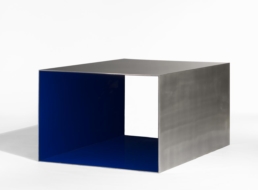
Donald Judd
Untitled – 1969-1971
Donald Clarence Judd (June 3, 1928 – February 12, 1994) was an American artist associated with minimalism (a term he nonetheless stridently disavowed). In his work, Judd sought autonomy and clarity for the constructed object and the space created by it, ultimately achieving a rigorously democratic presentation without compositional hierarchy. It created an outpouring of seemingly effervescent works that defied the term “minimalism”. Nevertheless, he is generally considered the leading international exponent of “minimalism,” and its most important theoretician through such seminal writings as “Specific Objects” (1964).
In the 1960s Donald Judd proposed a new way of making and experiencing art, breaking ground in the exploration of volume, interval, space and colour. He favoured industrial materials such as aluminium, perspex, sheet metal and plywood. From the mid 1960s onward all of Judd’s works were fabricated by skilled specialists to his precise specifications. By encouraging concentration on the volume and presence of the structure and the space around it, Judd’s work draws particular attention to the relationship between the object, the viewer and the specific context of the object’s environment. This relationship became a central focus of the artist’s career, and in later life he devoted much time to the installation of his work. Judd worked within an essential vocabulary of forms: ‘stacks’, ‘boxes’ and ‘progressions’.
Furniture design and architecture
In his later years, Judd also worked with furniture, design, and architecture. He was careful to distinguish his design practice from his artwork, writing in 1993:
The configuration and the scale of art cannot be transposed into furniture and architecture. The intent of art is different from that of the latter, which must be functional. If a chair or a building is not functional, if it appears to be only art, it is ridiculous. The art of a chair is not its resemblance to art, but is partly its reasonableness, usefulness and scale as a chair…A work of art exists as itself; a chair exists as a chair itself.
The first furniture was designed in 1973, when he moved from New York to Marfa. His designs included chairs, beds, shelves, desks and tables. Judd was initially prompted to design furniture by his own dissatisfaction with what was commercially available in Marfa. Early furniture was made by Judd of rough, lumberyard-cut pine but he continually refined the construction of the wooden pieces, employing craftspeople using a variety of techniques and materials around the world. In 1984, Judd commissioned Lehni AG, in Dübendorf, Switzerland to produce his furniture designs in sheet metal, in finishes of monochrome colored powdercoat based on the RAL colour standard, clear anodized aluminium, or solid copper. These designs are still produced by Lehni AG and sold through the Judd Foundation. In 1984, Judd drew upon his experience with this metal furniture by creating a series of colored artworks using the same techniques of powdercoating and bending. At the time of his death, he was working on designs for a fountain commissioned by the city of Winterthur in 1991, Switzerland, and a new glass facade for a railroad station in Basel, Switzerland.
